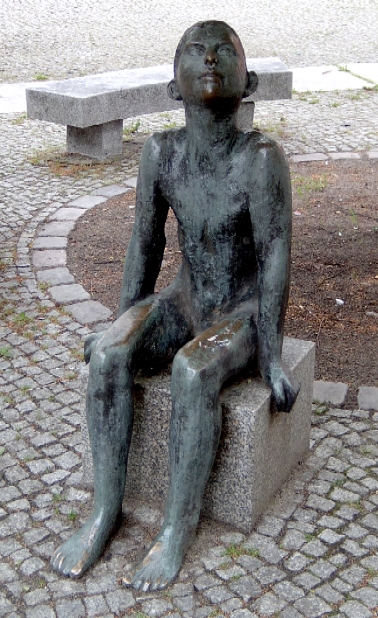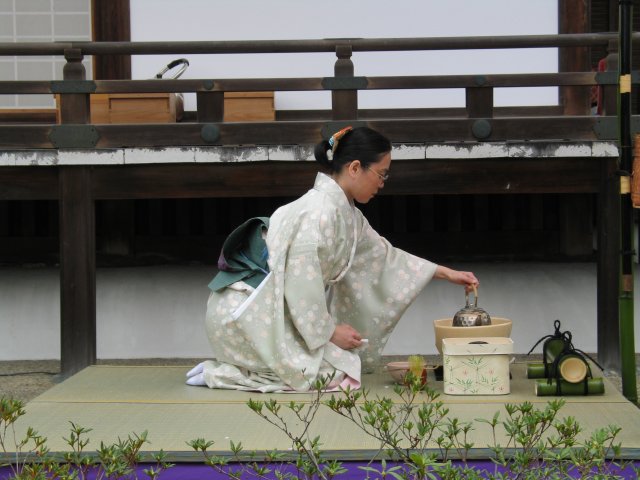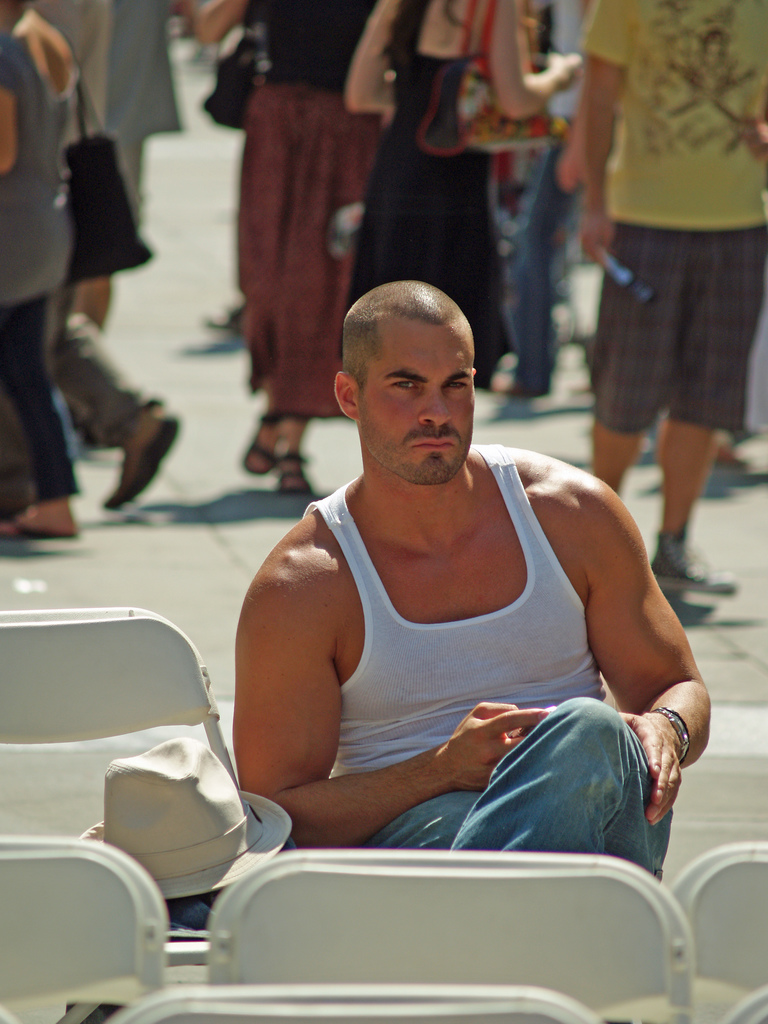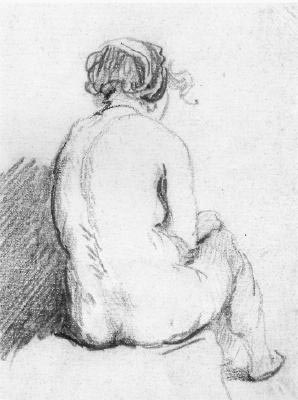Sitting From Wikipedia, the free encyclopedia
 |
| Sitzender Junge ("Sitting boy”) by Werner Stötzer, 1956 |
This article is about sitting in its general sense. For information about Zen sitting meditation, see Zazen.
Sitting is a rest position supported by the buttocks or thighs where the torso is more or less upright.
Types
Sitting on the floor
 |
| The Japanese tea ceremony is performed sitting in seiza. |
Sitting with bent legs can be done along two major lines; one with the legs mostly parallel and one where they cross each other. The parallel position is reminiscent of, and is sometimes used for, kneeling. The latter is a common pose for meditating. One variation that is highly unusual is the 'chicken wing' style. One would have their legs outwards facing backwards instead of folding them in front of themself.
Parallel Legs
- Seiza (正座?) "correct sitting" is a Japanese word which describes the traditional formal way of sitting in Japan. Sitting in seiza is kneeling on one's own lower legs, with the feet under the buttocks, toes pointed backwards. To sit in seiza for any length of time requires careful positioning of the heels under the sit bones of the hip, to minimize circulation loss. A related position is kiza (跪座?), which differs in the tops of the feet being raised off the ground.
- Vajrasana (Diamond Pose) is a yoga posture (asana) similar to seiza.
Cross-Legged
.jpg) |
| Girl sitting on a chair. |
- A common cross-legged position is with the lower part of both legs folded towards the body, crossing each other at the ankle or calf, with both ankles on the floor, sometimes with the feet tucked under the knees or thighs. The position is known in several European languages as tailor style, from the traditional working posture of tailors; compare tailor's bunion. It is also named after various plains-dwelling nomads: in English Indian style, in many European languages "Turkish style", and in Japanese agura (胡座 The sitting style of non-Han ethnics (particularly Turks, Mongols and other Central Asians.)?). In yoga it is known as sukhasana.
- The lotus position involves resting each foot on the opposite thigh so that the soles face upwards. If only one foot is brought into this position, it is called a half-lotus position. This position is common in yoga and meditation.
- The Burmese position, named so because of its use in Buddhist sculptures in Burma, places both feet in front of the pelvis with knees bent and touching the floor to the sides. The heels are pointing toward pelvis or upward, and toes are pointed so that the tops of the feet lie on the ground. This looks similar to the cross legged position, but the feet are not placed underneath the thigh of the next leg, therefore the legs do not cross. Instead, one foot is placed in front of the other. This is a popular sitting alternative for those less comfortable with the use of the Lotus or half Lotus positions in meditation and yoga.
Sitting on a Raised Seat
 |
| Women reclining in chairs. Painting by Jean-François de Troy. |
There are two major styles of sitting on a raised surface. The first has one or two of the legs in front of the sitting person; in the second, sitting astride something, the legs incline outwards on either side of the body.
The feet can rest on the floor, or on a footrest, which can keep them vertical, horizontal, or at an angle in between. They can also dangle if the seat is sufficiently high. Legs can be kept right to the front of the body, spread apart, or one crossed over the other.
The upper body can be held upright, recline to either side or backwards, or one can lean forward.
Posture
 |
| A man sitting in Brooklyn, New York. |
Recent studies indicate, however, that sitting upright for hours causes increased stress on the back, and may be a cause of chronic back pain. Researchers have found that a "135-degree back-thigh sitting posture" was the best posture to avoid back problems—that is, leaning back in the chair 45 degrees. Researchers found that the 90-degree position contributed most to strain on the spine, neck included, while the 135-degree position was the most relaxed.
Optimal posture while sitting is now referred to as neutral spine.
Variations
 |
| Back of a sitting nude by school of Rembrandt. |
Kneeling Chairs
The Kneeling chair (often just referred to as "ergonomic chairs"), was designed to encourage better posture than the conventional chair. To sit in a kneeling chair one rests one's buttocks on the upper sloping pad and rests the front of the lower legs atop the lower pad, i.e., the human position as both sitting and kneeling at the same time.
Mythology
In various mythologies and folk magic, sitting is a magical act that connects the person who sits, with other persons, states or places where he/she sat.
Sitting Defecation Posture
The sitting defecation posture involves sitting with hips and knees at approximately right angles, as on a chair. Most Western-style flush toilets are designed to be used with a sitting posture. The sitting posture is more widespread in the Western world, and less common in the developing world. Toilet seats are a recent development, only coming into widespread use in the nineteenth century.
Health Effects
Spending many hours sitting each day is related to raised mortality and CVD risk regardless of total physical activity. Inflammatory and metabolic risk factors partly explain this relationship.
The whole body is put at risk with prolonged sitting. When an individual is kept in an unnatural seated position for extended periods of time, their body starts to wear. Furthermore, the longer they remain in the upright position, the more at risk they are for injury. However, individuals can lower their risk by changing the way they sit, what they’re sitting on, and giving their body additional support with something as simple as a footrest. Some exercises, such as those seen in the book "Sit Sense", are designed to help attenuate the harmful effects of sitting. Some physical effects that computer users can experience are restricted blood flow to their muscles, such as neck, shoulders, upper limbs, and lower back. The concerns of overusing the computer are becoming so real that studies show just how the body deteriorates with prolonged sitting. The five major areas that have been studied are organ damage, muscle degeneration, leg disorders, unclear mindset, and bad back.
Prolonged sitting can cause organ damage because diseases such as heart disease have an easier way to penetrate the body. With limited movement, muscles burn less fat; furthermore the blood flows more sluggishly during the prolonged period, then giving fatty acids even more opportunity to easily clog the heart. Moreover, it has been shown that prolonged sitting has been linked to high blood pressure and raised cholesterol, and people with the most inactive time are more than twice as likely to have cardiovascular disease than others with the least.
Muscle degeneration is at also risk with prolonged sitting. One of the most underrated parts of the body are the hips. The hips allow one to keep balanced, however in the case of prolonged sitting, there is no available time to stretch the hip flexors. Rather, the hip flexors become shorter and tighter. One's future can be affected by this “action” of prolonged sitting because studies have shown that decreased hip mobility is one of the main reasons elderly people fall.
Leg disorders come with lack of movement during prolonged sitting. When individuals do not partake in activities such as walking and running, they lose the chance to engage hip and lower-body bones to grow thicker, denser, and stronger. These three factors can prevent diseases such as osteoporosis, which has been on the rise, and doctors credit this fact to the prolonged sitting at a computer.
See the full article:
Sitting From Wikipedia, the free encyclopedia

No comments:
Post a Comment